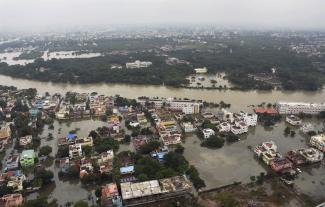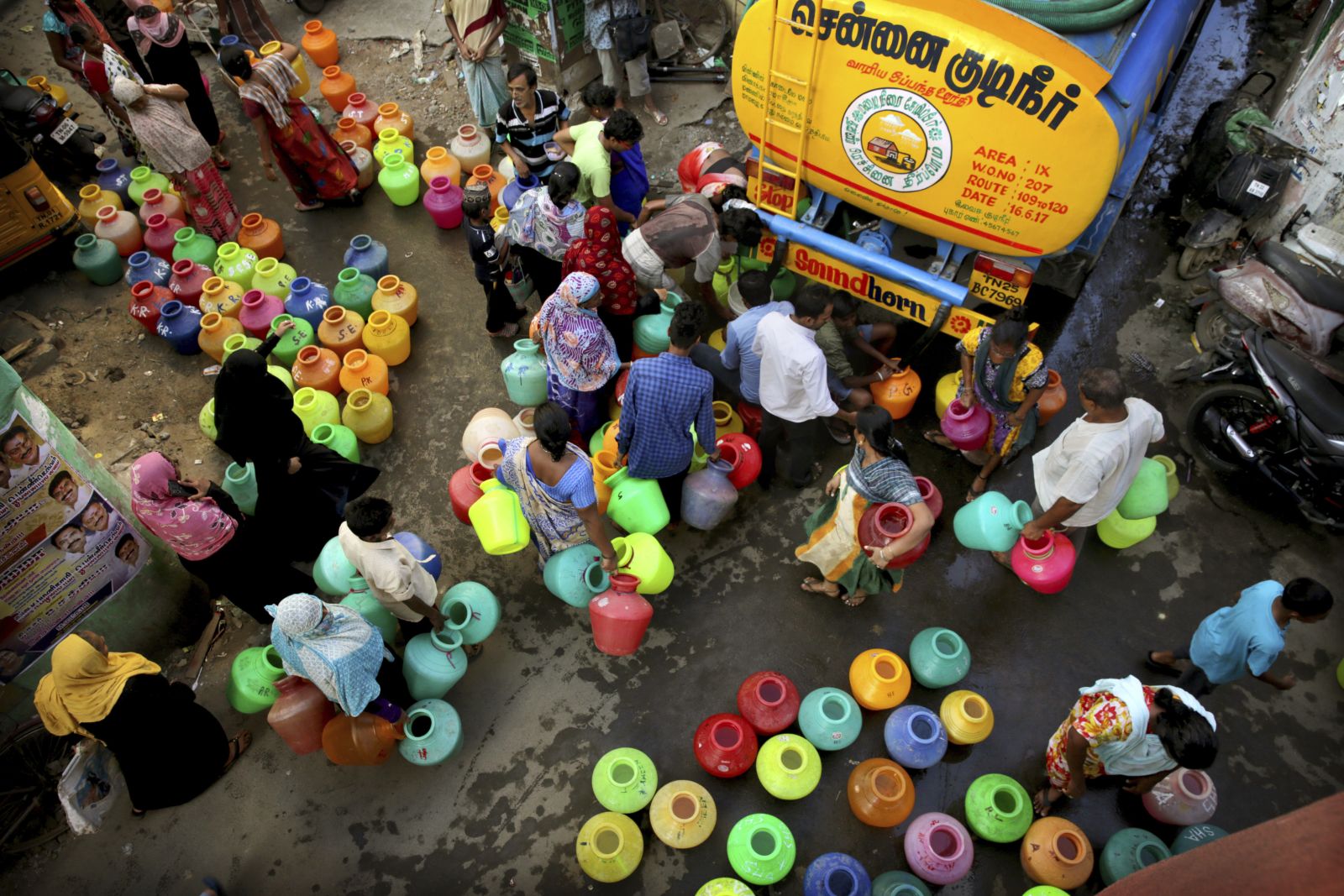Urban life
No water – or too much of it

Every year, as summer arrives, we brace for uncertainty in our city that was formerly known as Madras. In normal, pre-pandemic times, the main roads were a happy sight, with street vendors selling thinly sliced raw mangoes slathered in chillies and salt. During the hottest months – March to May – they also sell juicy water melon, ice apples and tender coconut water.
Unfortunately, the hot months are also when most smaller roads are crowded with people in queues waiting to fill pots and containers with water. Commercial and government tankers bring water to parched homes in the dead of the night or in the midst of a busy work day. No one knows when exactly they will arrive.
Water is scarce, so our agglomeration of 10 million people must get through the hottest, most humid days with as little water as possible. May is the worst month. This year, we are also in the midst of a nationwide lockdown because of the novel Coronavirus.
Many recall the frightful drought of 2019. Chennai’s municipal water-supply network went dry. For me personally, that was ironic. Lack of water affected us in the weeks before the release of my book on the catastrophic floods of 2015. At every book event I was asked whether I will write about the drought as well. I am not sure if I want to write about it yet. The truth is that Chennai is neither designed to cope with floods nor with droughts, but the climate crisis is making both ever more likely.
Chennai’s water comes from four reservoirs that are located a little outside the city. They are rain-water fed, which means that, when the monsoons fail, water shortages paralyse the city.
Chennai is the capital of the Indian state of Tamil Nadu. In 2017 and 2018, state politics was chaotic. Infighting kept our leaders so busy that they failed to notice the insufficient rainfall. The reckoning came in 2019 when the biggest reservoir, Chembarambakkam, went completely dry. News screens showed images of dead fish on the reservoir bed.
The irony was that the same reservoir had caused the 2015 floods. Back then, it had rained so hard it could not contain the water. Hundreds of families living along urban waterbodies were relocated to faraway places in suburban areas. They lost their possessions overnight, and then their claim to the city. During last year’s drought, the same families then had to spend a fourth of their daily incomes to buy water. The infrastructure of their new informal settlements is particularly poor.
Depending on Monsoon rain
Chennai receives most of its water from the northeast monsoon (about 60 %) in the months September to November. Last year, however, the northeast monsoon brought only 45 % of the long-term average. Because of that deficit, the city’s water-supply system failed.
Normally, the municipal corporation provides water to people, and we pay separate water taxes for that service. Last summer, we only got water once in 15 days where I live – and only for five minutes. The situation was even worse in other parts of the city.
When the pipes go dry, we can normally rely on borewell water which we source from the land our building stands on. Last summer, however, borewells dried out too. For the first time in nearly 17 years, the pump did not yield any water at all.
Like most of urban India, Chennai depends on groundwater for daily needs. In some places, this resource is over-used. For this reason, Tamil Nadu was one of the first states to make rain water harvesting compulsory in the city. The rule applies to all buildings – whether commercial or residential. When the rains fail, however, there is not much to harvest.
Borewell drilling was frantic last summer, sometimes with neighbours competing for groundwater. In several places people had to dig to a depth of more than 200 meters to even find water. According to official data, groundwater was vastly depleted in 22 of Tamil Nadu’s 38 districts. The hectic drilling was a scary glimpse of what the future will hold if the climate crisis escalates further.
At some point last year, everyone in Chennai had to buy water commercially. This struck a hard blow to the urban poor. The state government’s metropolitan water department, which normally provides water free of charge, sold this essential resource at a price of 700 rupees (the equivalent of about nine euros) per 9,000 litres. The price may seem low – and it was indeed the cheapest water available. The problem was that one had to wait for a long time to get it. The tanker we ordered only arrived after 20 days.
Everyone eventually had to turn to private suppliers. The price soared from 2,600 rupees for 9,000 litres in the beginning of the summer to a peak of 4,600 rupees. It sounds ridiculous in hindsight, but there was an extra charge for ‘clean water’. Otherwise the tanker dumped silted water into people’s home water storage area. This sharp rise in the cost of commercialised water hit the city’s poor and marginalised the most. Women were affected in particular (see box).
The state government was obviously unprepared. SP Velumani, its minister for municipalities and rural administration, even said that the drought was a rumour manufactured by the press. Soon after, Chennai had water shipments brought in by train.
Water is always a highly emotive issue in Tamil Nadu. State elections are fought over and won by who can bring irrigation water to the farmlands. Tamil Nadu is embroiled in fights over dams, reservoirs and river water with neighbouring states. A long-standing dispute with Karnataka can be traced back to the 19th century and concerns the river Cauvery. Last year, Kerala, another neighbour, offered extra water, but our state government turned it down, choosing politicking over people’s welfare.
Our ministers love photo opportunities when water is released from reservoirs and claim to personally have made it happen. Quick to take credit for success, they do not accept blame when a flood or drought occurs.
To tackle the problems long term, the city needs to improve its infrastructure. It is essential to rehabilitate hundreds of water bodies that have been encroached upon legally and illegally in the city. That would contribute to recharging groundwater and improving water tables in densely populated neighbourhoods.
Our ancient poets praised Tamil kings for the tanks they built. Unlike our politicians today, they understood how important water management is.
It is true that impacts of climate change are hard to predict – and it is even harder to build the infrastructure they make necessary. However, the time to prepare is now. It is a good sign that the state government has expressed awareness of the challenge. Its recent disaster-management plan mentions “climate change” 55 times. It proposes to restore damaged ecosystems and takes into account floods, droughts and other climate impacts. The assurances are still vague, but they do show that policymakers have noticed the problems.
That is not enough, of course. They must solve them, taking action in particular to protect the most vulnerable people. Chennai needs a water-management policy that serves the needs of the marginalised and oppressed communities. Piped water should not be a privilege of the rich.
Krupa Ge is a Chennai-based journalist. Her book “Rivers remember – #Chennairains and the shocking truth of a man-made flood” was published last summer (Delhi, Context).
krupa.ge@gmail.com








